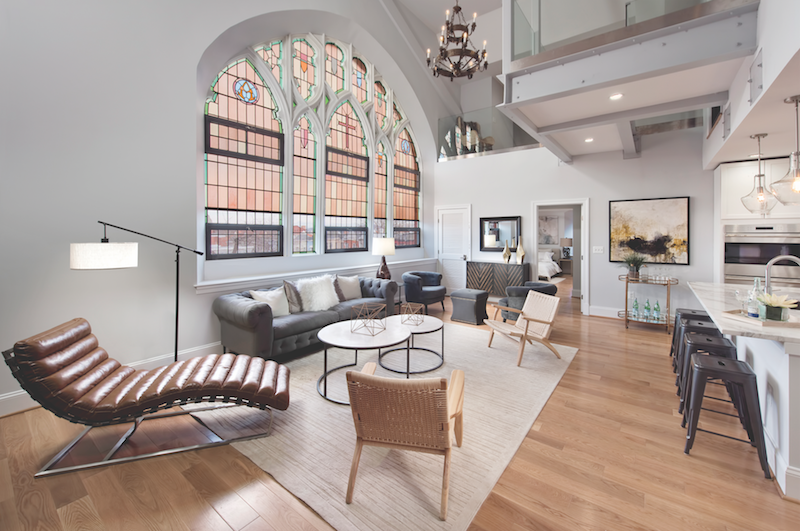One of the curious things about the Nation’s Capital is that, unlike many older U. S. cities, Washington, D. C., never had any industry to speak of—unless you count the manufacture of hot air as an industry. In the District of Columbia, you don’t see those wonderful 19th-century Italianate factories that dot the cityscapes of Boston, New York, Baltimore, Chicago—strong-boned, high-ceilinged brick edifices that convert into magnificent loft apartments, condominiums, and mixed-use centers.
What Washington does have aplenty is churches and other “religious locations” —by one count, 857, or one for every 758 residents. Until recently, the Way of the Cross Church, a Gothic Revival structure that dates to 1898, was among them. Today, it is the Sanctuary, a handsome 30-unit condominium complex at 819 D St., NE.
The Sanctuary may represent the vanguard of a new trend in Washington: the conversion of some of the city’s older churches—many of them located in emerging or already desirable neighborhoods—to sorely needed residential use.
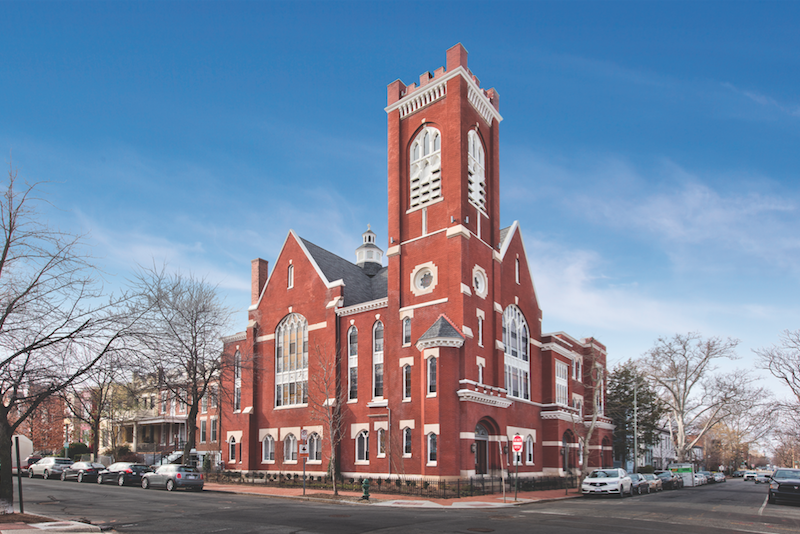 Exterior of the Sanctuary, at 816 D St., NE, Washington, D. C. The original Ninth Street Congregational Church dates from 1898. A three-story classroom annex built in 1916 now includes townhouses.
Exterior of the Sanctuary, at 816 D St., NE, Washington, D. C. The original Ninth Street Congregational Church dates from 1898. A three-story classroom annex built in 1916 now includes townhouses.
The church and its adjacent annex came on the market in 2014. The congregation had been migrating to the Maryland suburbs, and the sale of the church helped them finance construction of a larger building in Capitol Heights, Md. After some ownership changes, the quarter-acre property came under control of The Rubin Group, in partnership with real estate finance firm Regua. Andrew T. Rubin, Principal in the family-owned firm, brought in Bill Bonstra, FAIA, LEED AP, Founder of Washington design firm Bonstra | Haresign Architects, to lead the project.
In the course of the next two years, Rubin and Bonstra would learn more than they ever wanted to know about stained glass.
GETTING ALL THE NECESSARY APPROVALS
The first item on Rubin and Bonstra’s checklist was to obtain special zoning relief to change the building’s use to residential. Parking was the neighbors’ number one hot button. For years, local residents had been inconvenienced by church members taking up street parking on Sundays and weeknights. After meeting numerous times with the local Advisory Neighborhood Commission and other civic groups, Rubin and Bonstra were able to convince the locals that the parking problem would mostly go away once the church was shifted to residential use—especially with local bus, train, and new H Street trolley service in the neighborhood.
The more vexing problem had to do with the historic nature of the neighborhood. Although the church was not a designated landmark, because it was in the Capitol Hill Historic District and of a certain age, it was deemed a “’contributing building” under the District’s historic preservation guidelines. “Those buildings are what give the district its historical character,” says Gretchen Pfaehler, AIA, a member of the District’s Historic Preservation Review Board (HPRB).
Pfaehler, an Associate Partner at design firm Beyer Blinder Belle, was Chair of the HPRB at the time the Sanctuary came under its purview. She was particularly concerned about the stained glass windows, a subject in which she is an acknowledged authority. Under the code, she says, the windows were considered “artistic elements” that contributed “important character and effect” to the church.
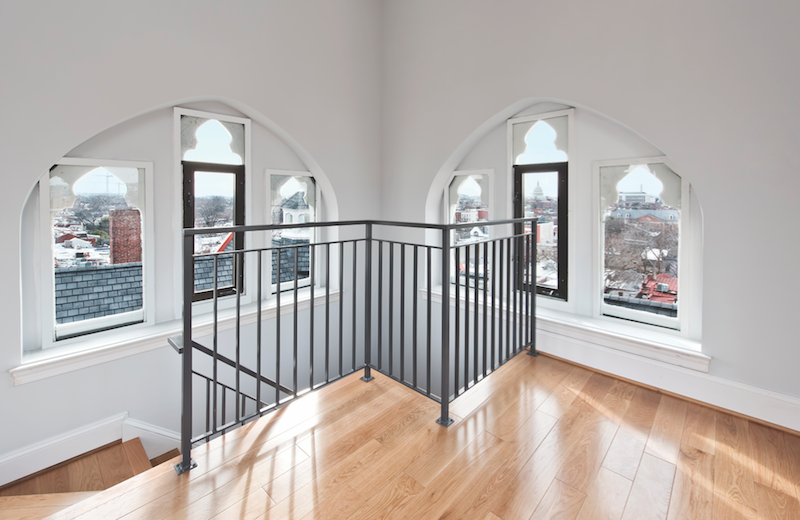 The view from the bell tower (which never had bells)—“now the highest privately owned view in D. C.,” according to developer Andrew T. Rubin.
The view from the bell tower (which never had bells)—“now the highest privately owned view in D. C.,” according to developer Andrew T. Rubin.
That position clashed with Bonstra and Rubin’s desire to make the building more appealing to prospective buyers by replacing translucent lites at eye level with transparent ones in some windows. “Stained glass might be good for spirituality,” Bonstra says, “but when you live in a building, you want to be able to look out the windows.”
The Review Board had denied two previous requests from developers who wanted to replace ornamental glass with clear glass; both decisions were upheld on appeal to the next higher authority. But they gave the Sanctuary team a chance to make the case for switching out the glass.
After conducting an extensive search, Bonstra and Rubin identified the glass restoration expert they believed could help them—Cumberland Stained Glass, Mechanicsburg, Pa. The 25-year-old studio is accredited by the Stained Glass Association of America.
The design team organized a site visit with Pfaehler and representatives from the D. C. Historic Preservation Office, the Capitol Hill Restoration Society, and the Advisory Neighborhood Commission. Cumberland’s President, Bryan Lerew, demonstrated a mocked-up window that illustrated how the lead matrix and ornamental design could be preserved, even if some lites were replaced with specialty transparent glass.
It was a textbook case of the effectiveness of physical mockups in building design. “The mockup did influence us,” says Pfaehler. “It allowed us to see the actual glazing in the appropriate lighting.” Lerew had specified a German-made glass (“Restover”) with a kind of distressed exterior side for the clear lites. The mockup helped overcome Pfaehler’s concerns about the sheen and reflectance of the clear glass as viewed from the street; at the same time, the glass provided the see-through visibility Bonstra and Rubin were looking for.
But the Review Board was not done. “We examined each window in detail to determine how much glass could be replaced without compromising the overall artistry of the window,” says Pfaehler. When Bonstra asked permission to punch holes in a street-facing wall for new windows, the board issued a categorical no. But they did allow new windows on the rear of the church and some operable windows for ventilation.
Following months of negotiation, the Review Board approved the revisions to the windows, although Pfaehler was emphatic that the decision applied only to the Sanctuary and was not to viewed as precedent setting.
Refurbishing the 132 windows took six of Cumberland’s technicians nine months, Lerew says. “The windows were badly out of repair, and the lead had outlived its life,” he says. Cumberland craftsmen painstakingly preserved 75% of the original glass and restored all the original designs. The total cost of the glasswork, according to Rubin: about 10% of the total $15.1 million construction cost.
SHORING UP THE STRUCTURE
The 85-foot-tall bell tower needed major structural reinforcement. “We removed about four feet of the original wall all the way to the basement, then poured a 28-by-42-inch concrete column and laid engineered structural beams,” says Brian Lucey, Potomac Construction Group’s Vice President of Operations.
Inserting the shaft for the new three-story KONE elevator between the church and the old classroom annex proved vexing for Potomac and structural engineer Structura. Concrete in the annex had to be demolished, underpinning placed around the foundations, and new footings laid. “We had to shore up each concrete floor as we moved up, putting in new cinder block shaft walls to the roof,” says Lucey.
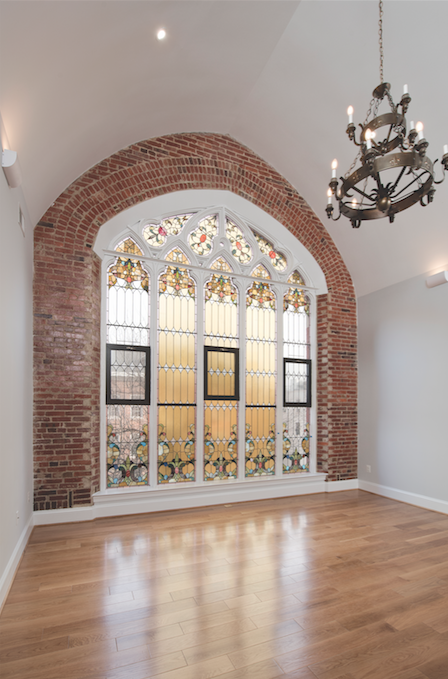 Potomac Construction Group crews carefully preserved light fixtures and original brick throughout the nearly 35,000-sf restoration. Note the special German-made transparent glass and the operable windows, two features the developer and design team worked hard to convince the District of Columbia Historic Preservation Review Board to approve.
Potomac Construction Group crews carefully preserved light fixtures and original brick throughout the nearly 35,000-sf restoration. Note the special German-made transparent glass and the operable windows, two features the developer and design team worked hard to convince the District of Columbia Historic Preservation Review Board to approve.
“The window lines throughout the building varied due to the differences in structure and purpose of the church and annex,” says Colin Drumright, Project Architect, Bonstra | Haresign. “We incorporated these differences into the living units by having double-height spaces and varied floor elevations on the third floor.” Sloped seating in the choir loft was demolished to gain the proper alignment, he notes.
Potomac finished the 34,693-sf job last New Year’s Eve. By September, the 29 one- and two-bedroom units (440 to 1,900 sf) were sold out. The penthouse (two bedrooms/2.5 baths) went for $1,525,000, a condo sales figure the city’s Northeast quadrant had not seen since 2008.
The Sanctuary received an Award of Excellence in Historic Architecture from AIA Northern Virginia. Next month, it will be announced as a winner in Building Design+Construction’s Reconstruction Awards.
The conversion of the church had an almost Damascene effect on the participants. “We felt more like stewards of the building than developers,” says Rubin. “The church started telling us what to do.”
PROJECT TEAM | THE SANCTUARY
CLIENT The Rubin Group, in partnership with Regua ARCHITECT Bonstra | Haresign Architects STRUCTURAL ENGINEER Structura CIVIL ENGINEER VIKA Capitol MECHANICAL ENGINEER Capitol Engineering Group GLASS CONSULTANT Cumberland Stained Glass GC Potomac Construction Group
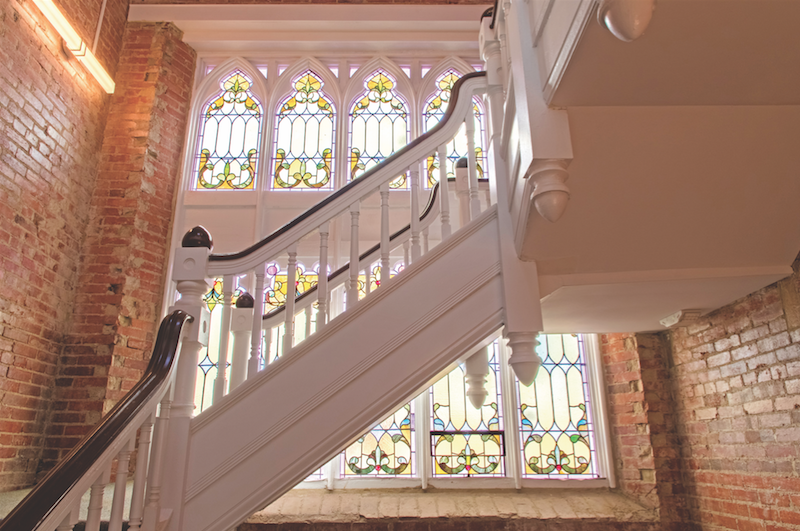 Plaster was removed from the walls in the main stairwell (and elsewhere) to reveal the original brick. The wooden balustrade was restored.
Plaster was removed from the walls in the main stairwell (and elsewhere) to reveal the original brick. The wooden balustrade was restored.
Related Stories
MFPRO+ New Projects | Oct 30, 2024
BIG’s One High Line finally reaches completion in New York City’s West Chelsea neighborhood
One High Line, a luxury residential project spanning a full city block in New York’s West Chelsea neighborhood, reached completion this summer following years of delays related to investor lawsuits.
MFPRO+ New Projects | Oct 30, 2024
Luxury waterfront tower in Brooklyn features East River and Manhattan skyline views
Leasing recently began for The Dupont, a 41-story luxury rental property along the Brooklyn, N.Y., waterfront. Located within the 22-acre Greenpoint Landing, where it overlooks the newly constructed Newtown Barge Park, the high-rise features East River and Manhattan skyline views along with 20,000 sf of indoor and outdoor communal space.
Multifamily Housing | Oct 28, 2024
A case for mid-rise: How multifamily housing can reshape our cities
Often referred to as “five-over-ones,” the mid-rise apartment type is typically comprised of five stories of apartments on top of a concrete “podium” of ground-floor retail. The main criticism of the “five-over-one” is that they are often too predictable.
Adaptive Reuse | Oct 22, 2024
Adaptive reuse project transforms 1840s-era mill building into rental housing
A recently opened multifamily property in Lawrence, Mass., is an adaptive reuse of an 1840s-era mill building. Stone Mill Lofts is one of the first all-electric mixed-income multifamily properties in Massachusetts. The all-electric building meets ambitious modern energy codes and stringent National Park Service historic preservation guidelines.
MFPRO+ News | Oct 22, 2024
Project financing tempers robust demand for multifamily housing
AEC Giants with multifamily practices report that the sector has been struggling over the past year, despite the high demand for housing, especially affordable products.
Products and Materials | Oct 17, 2024
5 multifamily tech products for your next project
Multifamily housing and technological upgrades go hand-in-hand. From the rise in electric vehicle charging needs to the sophistication of smart home accessories, tech products are abound in the multifamily space.
Codes and Standards | Oct 16, 2024
North Carolina’s code policies likely worsened damage caused by Hurricane Helene
The North Carolina Legislature’s rejection of building code updates likely worsened the damage caused by Hurricane Helene, code experts say. Over the past 15 years, lawmakers rejected limits on construction on steep slopes, which might have reduced the number of homes destroyed by landslides.
MFPRO+ News | Oct 16, 2024
One-third of young adults say hurricanes like Helene and Milton will impact where they choose to live
Nearly one-third of U.S. residents between 18 and 34 years old say they are reconsidering where they want to move after seeing the damage wrought by Hurricane Helene, according to a Redfin report. About 15% of those over age 35 echoed their younger cohort’s sentiment.
Student Housing | Oct 9, 2024
University of Maryland begins work on $148 million graduate student housing development
The University of Maryland, in partnership with Campus Apartments and Mosaic Development Partners, has broken ground on a $148.75 million graduate student housing project on the university’s flagship College Park campus. The project will add 741 beds in 465 fully furnished apartments.
MFPRO+ News | Oct 9, 2024
San Francisco unveils guidelines to streamline office-to-residential conversions
The San Francisco Department of Building Inspection announced a series of new building code guidelines clarifying adaptive reuse code provisions and exceptions for converting office-to-residential buildings. Developed in response to the Commercial to Residential Adaptive Reuse program established in July 2023, the guidelines aim to increase the viability of converting underutilized office buildings into housing by reducing regulatory barriers in specific zoning districts downtown.


